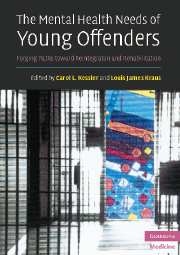Book contents
- Frontmatter
- Contents
- List of contributors
- Foreword
- Acknowledgments
- 1 An overview of child and adolescent mental health needs in the juvenile justice system
- 2 Psychiatric disorders of youth in detention
- 3 Disproportionate minority confinement
- 4 Police interrogation of youth
- 5 Assessing children's competence to stand trial and to waive Miranda rights: new directions for legal and medical decision-making in juvenile courts
- 6 The etiology of antisocial behavior: biopsychosocial risk factors across development
- 7 Substance abuse in youth offenders
- 8 Suicide and delinquent adolescents
- 9 Juvenile sex offenders
- 10 Educational needs of youth in the juvenile justice system
- 11 Science and the juvenile death penalty
- 12 Medical issues regarding incarcerated adolescents
- 13 Mental health screening and assessment in juvenile justice
- 14 Psychological testing in juvenile justice settings
- 15 Psychopharmacology and juvenile delinquency
- 16 Evidence-based treatment for justice-involved youth
- 17 Community alternatives to incarceration
- 18 Innovative problem-solving court models for justice-involved youth
- 19 Ethical issues of youthful offenders: confidentiality; right to receive and to refuse treatment; seclusion and restraint
- 20 Post-adjudicatory assessment of youth
- Index
- References
18 - Innovative problem-solving court models for justice-involved youth
Published online by Cambridge University Press: 11 August 2009
- Frontmatter
- Contents
- List of contributors
- Foreword
- Acknowledgments
- 1 An overview of child and adolescent mental health needs in the juvenile justice system
- 2 Psychiatric disorders of youth in detention
- 3 Disproportionate minority confinement
- 4 Police interrogation of youth
- 5 Assessing children's competence to stand trial and to waive Miranda rights: new directions for legal and medical decision-making in juvenile courts
- 6 The etiology of antisocial behavior: biopsychosocial risk factors across development
- 7 Substance abuse in youth offenders
- 8 Suicide and delinquent adolescents
- 9 Juvenile sex offenders
- 10 Educational needs of youth in the juvenile justice system
- 11 Science and the juvenile death penalty
- 12 Medical issues regarding incarcerated adolescents
- 13 Mental health screening and assessment in juvenile justice
- 14 Psychological testing in juvenile justice settings
- 15 Psychopharmacology and juvenile delinquency
- 16 Evidence-based treatment for justice-involved youth
- 17 Community alternatives to incarceration
- 18 Innovative problem-solving court models for justice-involved youth
- 19 Ethical issues of youthful offenders: confidentiality; right to receive and to refuse treatment; seclusion and restraint
- 20 Post-adjudicatory assessment of youth
- Index
- References
Summary
The traditional adjudication process for youth has been wrought with such difficulties as overcrowded detention centers, delay in processing cases, and ineffective case dispositions. The US juvenile justice system, in response to the pressure of an increase in youth crime in the 1980s, resorted to increased detention and transfer to adult court. Punitive models threatened to overtake the heart of the juvenile justice system – a system predicated on the commitment to offer youth rehabilitation and integration into their communities.
Despite a trend toward punishment, committed teams of judges, lawyers, law enforcement officers, probation officers, community leaders, and mental health providers have fashioned creative alternatives to traditional adjudication. They aim to address such root causes of delinquent behavior as mental illness, substance abuse, academic failure, and family disintegration. The process of adjudication is transformed into a therapeutic, rehabilitative approach, wherein young people's needs are assessed and addressed. Youth at risk are seen as youth in need of support – a term that youth advocates coined for themselves at a recent meeting convened by the American Bar Association's Youth at Risk Initiative.
Problem-solving courts search for young people's strengths, and endeavor to support youth with needed educational, vocational, health, and mental health services. They seek to deliver services in a culturally relevant, developmentally appropriate manner, and they strive to link youth to effective aftercare.
These courts embody a model of restorative justice. Reparations are made by the youth to his/her community and by the community to their youth.
Keywords
- Type
- Chapter
- Information
- The Mental Health Needs of Young OffendersForging Paths toward Reintegration and Rehabilitation, pp. 385 - 400Publisher: Cambridge University PressPrint publication year: 2007



